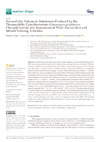Please use this identifier to cite or link to this item:
https://accedacris.ulpgc.es/jspui/handle/10553/114302
| Title: | Extracellular Polymeric Substances Produced by the Thermophilic Cyanobacterium Gloeocapsa gelatinosa: Characterization and Assessment of Their Antioxidant and Metal-Chelating Activities | Authors: | Gongi, Wejdene Gómez Pinchetti, Juan Luis Cordeiro, Nereida Ouada, Hatem Ben |
UNESCO Clasification: | 3302 Tecnología bioquímica 241707 Algología (ficología) 221090 Química-física de polímeros |
Keywords: | Gloeocapsa gelatinosa Extracellular polymeric substances Physicochemical characterization Functional properties Antioxidant activity, et al |
Issue Date: | 2022 | Project: | Red de Excelencia en Biotecnología Azul (Algas) de la Región Macaronésica. Consolidación, Certificación y Transferencia Implementation and Sustainability of Microbial Resource Research Infrastructure for 21st Century |
Journal: | Marine Drugs | Abstract: | Cyanobacteria, particularly thermophilic strains, represent an important potential source of EPSs, harboring structural complexity that predicts diverse and specific bioactive potential. The thermophilic cyanobacteria Gloeocapsa gelatinosa, isolated from a natural hot source in Ain Echfa (Tunisia), was cultivated in a cylindrical reactor, and the production of biomass and EPSs was investigated. Results revealed that the strain is amongst the most efficient EPSs producers (0.89 g L−1) and that EPSs production was not correlated with the growth phase. EPSs were sulfated heteropolysaccharides containing carbohydrates (70%) based on nine different monosaccharides, mainly mannose (22%), and with the presence of two uronic acids. EPSs were formed by two polymers moieties with a molecular weight of 598.3 ± 7.2 and 67.2 ± 4.4 kDa. They are thermostable in temperatures exceeding 100 °C and have an anionic nature (zeta potential of −40 ± 2 mV). Atomic force microscopy showed that EPSs formed multimodal lumps with 88 nm maximum height. EPSs presented high water holding capacity (70.29 ± 2.36%) and solubility index (97.43 ± 1.24%), and a strong bivalent metal sorption capacity especially for Cu2+ (91.20 ± 1.25%) and Fe2+ (75.51 ± 0.71%). The antioxidant activity of G. gelatinosa EPSs was investigated using four methods: the β-carotene-bleaching activity, DPPH assays, iron-reducing activity, and metal-chelating activity. EPS has shown high potential as free radicals’ scavenger, with an IC50 on DPPH (0.2 g L−1) three-fold lower than ascorbic acid (0.6 g L −1) and as a metal chelating activity (IC50 = 0.4 g L−1) significantly lower than EDTA. The obtained results allow further exploration of the thermophilic G. gelatinosa for several biotechnological and industrial applications. | URI: | https://accedacris.ulpgc.es/handle/10553/114302 | ISSN: | 1660-3397 | DOI: | 10.3390/md20040227 | Source: | Marine Drugs [ISSN 1660-3397], v. 20(4), 227, (Marzo 2022) |
| Appears in Collections: | Artículos |
SCOPUSTM
Citations
19
checked on Jun 8, 2025
WEB OF SCIENCETM
Citations
17
checked on Jun 8, 2025
Page view(s)
118
checked on Dec 28, 2024
Download(s)
160
checked on Dec 28, 2024
Google ScholarTM
Check
Altmetric
Share
Export metadata
Items in accedaCRIS are protected by copyright, with all rights reserved, unless otherwise indicated.
